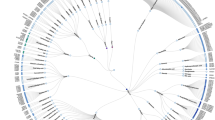Abstract
We investigated the effects of our synthetic bombesin/gastrin-releasing peptide (GRP) antagonists and somatostatin analogue RC-160 on the growth of human small-cell lung carcinoma (SCLC) and non-small-cell lung carcinoma (non-SCLC) lines in nude mice. Athymic nude mice bearing xenografts of the SCLC NCl-H69 line or non-SCLC NCl-H157 line were treated for 5 and 4 weeks, respectively, with somatostatin analogue RC-160 or various bombesin/GRP antagonists. RC-160, administered s.c. peritumorally at a dose of 100 micrograms per animal per day, inhibited the growth of H69 SCLC xenografts as shown by more than 70% reduction in tumour volumes and weights, as compared with the control group. Bombesin/GRP antagonists, RC-3440, RC-3095 and RC-3950-II, given s.c. peritumorally at a dose of 20 micrograms per animal per day, also inhibited the growth of H69 SCLC tumours. RC-3950-II had the greatest inhibitory effect and decreased tumour volume and weights by more than 80%. The growth of H-157 non-SCLC xenografts was significantly reduced by treatment with RC-160, but not with bombesin/GRP antagonist RC-3095. In mice bearing either tumour model, administration of RC-160 significantly decreased serum growth hormone and gastrin levels. Specific high-affinity receptors for bombesin and somatostatin were found on membranes of SCLC H69 tumours, but not on non-SCLC H157 tumours. Receptor analyses demonstrated high-affinity binding sites for epidermal growth factor (EGF) and insulin-like growth factor I (IGF-I) on the membranes of H69 and H157 tumours. EGF receptors were down-regulated on H69 tumours after treatment with RC-160 and bombesin/GRP antagonists. The concentration of binding sites for EGF and IGF-I on the H157 tumours was decreased after treatment with RC-160, but bombesin/GRP antagonist RC-3095 had no effect. These results demonstrate that bombesin/GRP antagonists inhibit the growth of H-69 SCLC, but not of H-157 non-SCLC xenografts in nude mice, whereas somatostatin analogue RC-160 is effective in both tumour models. This raises the possibility that these peptide analogues could be used selectively in the treatment of various subclasses of lung cancer.
This is a preview of subscription content, access via your institution
Access options
Subscribe to this journal
Receive 24 print issues and online access
$259.00 per year
only $10.79 per issue
Buy this article
- Purchase on Springer Link
- Instant access to full article PDF
Prices may be subject to local taxes which are calculated during checkout
Similar content being viewed by others
Author information
Authors and Affiliations
Rights and permissions
About this article
Cite this article
Pinski, J., Schally, A., Halmos, G. et al. Effects of somatostatin analogue RC-160 and bombesin/gastrin-releasing peptide antagonists on the growth of human small-cell and non-small-cell lung carcinomas in nude mice. Br J Cancer 70, 886–892 (1994). https://doi.org/10.1038/bjc.1994.415
Issue Date:
DOI: https://doi.org/10.1038/bjc.1994.415
This article is cited by
-
Detection of somatostatin receptors in human osteosarcoma
World Journal of Surgical Oncology (2008)
-
Mitogenic effects of gastrin-releasing peptide in head and neck squamous cancer cells are mediated by activation of the epidermal growth factor receptor
Oncogene (2003)
-
Inhibition of growth of human malignant glioblastoma in nude mice by antagonists of bombesin/gastrin-releasing peptide
Oncogene (1999)
-
Targeted cytotoxic analogue of bombesin/ gastrin-releasing peptide inhibits the growth of H-69 human small-cell lung carcinoma in nude mice
British Journal of Cancer (1999)
-
Phase II study of RC-160 (vapreotide), an octapeptide analogue of somatostatin, in the treatment of metastatic breast cancer
British Journal of Cancer (1999)



